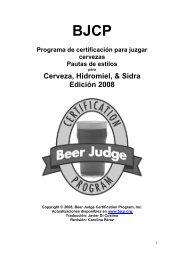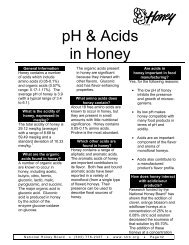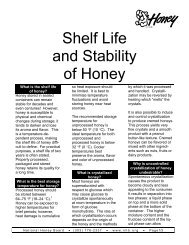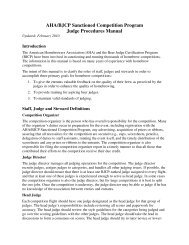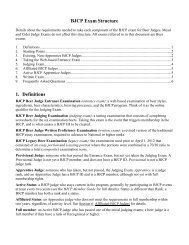Cap Management in Melomel - BJCP
Cap Management in Melomel - BJCP
Cap Management in Melomel - BJCP
Create successful ePaper yourself
Turn your PDF publications into a flip-book with our unique Google optimized e-Paper software.
<strong>Cap</strong> <strong>Management</strong> <strong>in</strong> <strong>Melomel</strong> (Fruit Meads):<br />
By P. Bakulić<br />
What is a “<strong>Cap</strong>”<br />
The <strong>Cap</strong> is the layer of fruit that floats up and his held at the top of the<br />
fermentation vessel by CO 2 dur<strong>in</strong>g fermentation of a melomel with fruit<br />
<strong>in</strong> the primary. This term comes from the conical shape of the heaped<br />
up pomace (<strong>in</strong> grape w<strong>in</strong>emak<strong>in</strong>g) emerg<strong>in</strong>g from the open tanks,<br />
which is collected together after hav<strong>in</strong>g been piagé, that is to say<br />
trampled with the feet. (Peynaud 1981)<br />
<strong>Cap</strong> management:<br />
Manag<strong>in</strong>g the fruit cap dur<strong>in</strong>g early fermentation is especially<br />
important as there are key factors discussed below that contribute to<br />
the "loss" or "burn off" of fruit flavor, yeast stress, stuck fermentation,<br />
off flavors/characters, and failure to maximize the fruit character<br />
dur<strong>in</strong>g primary when us<strong>in</strong>g fruit (whether fresh, frozen, dried, etc.) if<br />
the cap is not broken up regularly throughout the course of the<br />
primary fermentation.<br />
Heat, Sugar and Yeast:<br />
For every 1 degree of brix reduction by fermentation of your must<br />
there is a 2.3 o F <strong>in</strong>crease <strong>in</strong> temperature. The temperature can build<br />
up very quickly and kill off the yeast liv<strong>in</strong>g <strong>in</strong> the "heat zone" below<br />
the cap when the temperature rises above 104-106 o F. You'll literally<br />
cook off a lot of the floral, fruity characters from the berries/fruit<br />
you're us<strong>in</strong>g. You'll also lose a good percentage of your yeast and have<br />
a stuck fermentation to boot.<br />
Along with that you'll have off flavors from the yeast be<strong>in</strong>g stressed<br />
out before they kick off. F<strong>in</strong>ally by mix<strong>in</strong>g the berries back down <strong>in</strong>to<br />
the must you facilitate extraction of color, tann<strong>in</strong>, aroma, flavor and<br />
fruity character hence the f<strong>in</strong>al mead will present with more of the<br />
flavor of the fruit.<br />
It is also necessary to punch down frequently to redistribute the yeast<br />
(the highest concentration of yeast are found <strong>in</strong> and directly below the<br />
cap) throughout the fermentation vessel <strong>in</strong> order to promote a more<br />
uniform fermentation.<br />
This is especially important when one realizes that as the yeast<br />
population differs <strong>in</strong> various portions of the tank, the reduction of<br />
sugar through fermentation will be uneven if the cap is not punched<br />
down and mixed back <strong>in</strong>to the must. Thus it is critical that the cap be<br />
managed effectively <strong>in</strong> order to homogenize the yeast, sugar and<br />
temperature distribution with<strong>in</strong> the fermentation vessel.
CO 2 :<br />
If the cap is not broken up or "punched down" the CO 2 buildup under<br />
the cap will deprive your yeast of oxygen. Oxygen is required by the<br />
yeast for optimal ethanol tolerance. This is why we aerate dur<strong>in</strong>g the<br />
first third of fermentation <strong>in</strong> order to get O2 <strong>in</strong>to the must for the<br />
yeast which enables the synthesis of sterols <strong>in</strong> order to strengthen the<br />
cell walls. One may th<strong>in</strong>k of O2 as a rudimentary yeast nutrient dur<strong>in</strong>g<br />
early fermentation for the benefit of the cell walls. Healthy cell walls<br />
are needed to:<br />
• Provide resistance to the rapidly ris<strong>in</strong>g level of alcohol<br />
• Regulate osmotic pressure across the cell wall<br />
• Effectively transport nitrogen <strong>in</strong>to the cell<br />
• Help regulate pH with<strong>in</strong> the cytoplasm<br />
• Ensure that the yeast cells are able to reproduce efficiently and<br />
proceed unstressed throughout the fermentation<br />
Aga<strong>in</strong>, if the yeast is not perform<strong>in</strong>g to it's spec based on improper cap<br />
management or nutrient poor must, the fermentation be become<br />
stuck, or just drag on forever.<br />
Dry<strong>in</strong>g:<br />
If the cap isn't pressed down <strong>in</strong>to the must frequently (this depends on<br />
how much fruit you use, along with the type of fruit, i.e. purees will<br />
take less punch<strong>in</strong>g down than crushed fresh, frozen or rehydrated<br />
dried fruit) to keep it moist the top will dry and spoilage organisms can<br />
set <strong>in</strong> which then compete with your yeast produc<strong>in</strong>g off flavors, or<br />
worse completely spoil<strong>in</strong>g your mead. Aga<strong>in</strong>, if the yeast is<br />
compromised <strong>in</strong>to a position of fight<strong>in</strong>g for dom<strong>in</strong>ance <strong>in</strong> the must,<br />
they will not be do<strong>in</strong>g their primary job of a fast, clean ferment.<br />
Early exposure to oxygen for both the yeast and the fruit dur<strong>in</strong>g<br />
primary is very important <strong>in</strong> the formation of the overall fruit flavor<br />
and character. S<strong>in</strong>k<strong>in</strong>g the fruit <strong>in</strong> a gra<strong>in</strong> bag is also practiced widely<br />
and yields very good results. Bear <strong>in</strong> m<strong>in</strong>d that for very large fruit<br />
additions (3-4 lbs of fruit/gallon of must) us<strong>in</strong>g a gra<strong>in</strong> bag may be<br />
impractical and the use of a plastic bucket provides easier<br />
management and access to the ferment<strong>in</strong>g must and fruit.






